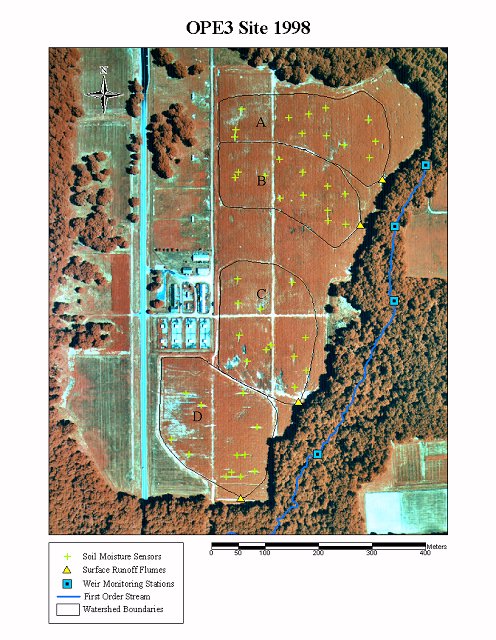|
|
|
 |
Optimizing Production Inputs for Economic and
Environmental Enhancement (OPE3 )
|
OPE3 is an international research program involving U.S. Federal agencies, Universities, and private industry. The infrastructure of OPE3 provides a meaningful comparison of agricultural production systems with a research site that is large enough to capture the spatial variability of crop and soil parameters, yet not so large that the fields themselves are in different climatic or geologic settings. This site has four hydrologically bounded watersheds, 4 ha each, which feed a wooded riparian wetland and first-order stream. |
|
|
Color Infrared Aerial Photography of OPE3

|
Major Objectives:
i) determine atmospheric, surface
and subsurface watershed-
scale fluxes of water, plant
nutrients, and pesticides from
three crop production systems;
ii) determine the behavior and
environmental impact of
chemical inputs on a wooded
riparian wetland and first-order
stream;
ii) develop remotely sensed data
products and analytical
techniques for measuring and
managing the spatial variability
of crops and soils;
iv) determine long-term economic
and environmental impacts
from three crop production
systems and evaluate their
tradeoffs using integrated
economic and biophysical
simulation models.
|
| Structure and Philosophy:
Although in its infancy, over 60 scientists internationally are involved on the OPE3 project, representing universities, government agencies, and industry. The project focuses on developing process-based algorithms and models at various spatial scales to resolve complex environmental and economic issues. Each research group involved with OPE3 must acquire its own funding, usually through competitive grants and contribute data to the overall project. By sharing data sets, scientists can leverage exiting fiscal and human resources when seeking grants.
|
|
|
|
|

